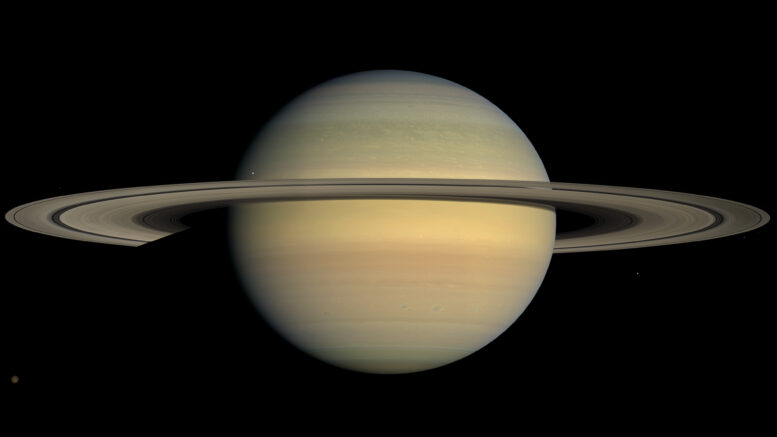Saturn is the most distant of the five planets easily visible to the naked eye from Earth, the other four being Mercury, Venus, Mars and Jupiter. Saturn appears to the naked eye in the night sky as a bright, yellowish point of light. Saturn and its rings are best seen when the planet is at, or near, opposition, the configuration of a planet when it is at an elongation of 180°, and thus appears opposite the Sun in the sky. A Saturnian opposition occurs every year, approximately every 378 days, which results in the planet appearing at its brightest.
Viewing Saturn in the Pacific Northwest, is best done during the summer months, as Saturn rises from the East and is often best seen in July all the way to the September timeframe. Saturn is visible in the May and June months, but that is in the early morning near Jupiter on the Eastern Horizon. Viewing Saturn can be done with a small or medium sized telescope in your backyard! Larger telescopes will provide more detail, but small telescopes can allow viewers the ability to view the rings and some moons.
The observation and exploration of Saturn can be divided into three phases. The first phase is ancient observations, before the invention of modern telescopes. The second phase began in the 17th century, with telescopic observations from Earth, which improved over time. The third phase is visitation by space probes, in orbit or on flyby. In the 21st century, telescopic observations continue from Earth and, until its 2017 retirement, from the Cassini orbiter around Saturn. We will discuss the scientific missions in greater detail in a future article, so stick around for that.
Saturn has been known since prehistoric times, [1] and in early recorded history it was a major character in various mythologies. Babylonian astronomers systematically observed and recorded the movements of Saturn. [2] In ancient Greek, the planet was known as Φαίνων Phainon, [3], and in Roman times it was known as the “star of Saturn”.[4] In ancient Roman mythology, the planet Phainon was sacred to this agricultural god, from which the planet takes its modern name.[5] The Romans considered the god Saturnus the equivalent of the Greek god Cronus; in modern Greek, the planet retains the name Cronus—Κρόνος: Kronos.[6]
The Greek scientist Ptolemy based his calculations of Saturn’s orbit on observations he made while it was in opposition.[7] In Hindu astrology, there are nine astrological objects, known as Navagrahas. Saturn is known as “Shani” and judges everyone based on the good and bad deeds performed in life.[6] Ancient Chinese and Japanese culture designated the planet Saturn as the “earth star”. This was based on Five Elements which were traditionally used to classify natural elements.[8]
In ancient Hebrew, Saturn is called ‘Shabbathai’.[9] In Ottoman Turkish, Urdu and Malay, the name of Zazel is ‘Zuhal’, derived from the Arabic language.[10]
European Observations Of Saturn
Robert Hooke noted the shadows cast by both the globe and the rings on each other in this drawing of Saturn in 1666.
Saturn’s rings require at least a 15-mm-diameter telescope [11] to resolve and thus were not known to exist until Christiaan Huygens saw them in 1659. Galileo, with his primitive telescope in 1610, [12] incorrectly thought of Saturn’s appearing not quite round as two moons on Saturn’s sides.[13] It was not until Huygens used greater telescopic magnification that this notion was refuted, and the rings were truly seen for the first time. Huygens also discovered Saturn’s moon Titan; Giovanni Domenico Cassini later discovered four other moons: Iapetus, Rhea, Tethys and Dione. In 1675, Cassini discovered the gap now known as the Cassini Division.[14]
No further discoveries of significance were made until 1789 when William Herschel discovered two further moons, Mimas and Enceladus. The irregularly shaped satellite Hyperion, which has a resonance with Titan, was discovered in 1848 by a British team.[15]
In 1899 William Henry Pickering discovered Phoebe, a highly irregular satellite that does not rotate synchronously with Saturn as the larger moons do.[15] Phoebe was the first such satellite found and it takes more than a year to orbit Saturn in a retrograde orbit. During the early 20th century, research on Titan led to the confirmation in 1944 that it had a thick atmosphere – a feature unique among the Solar System’s moons.
Check out the Planetary Bodies Category for previous and upcoming articles on the solar system planets.
Sources
[1] = Observing Saturn”. National Maritime Museum. 20 August 2015. Archived from the original on 22 April 2007.
[2] = Sachs, A. (2 May 1974). “Babylonian Observational Astronomy”. Philosophical Transactions of the Royal Society of London. 276(1257): 43–50. Bibcode:1974RSPTA.276…43S.
[3] = Φαίνων. Liddell, Henry George; Scott, Robert; An Intermediate Greek–English Lexicon at the Perseus Project.
[4] = Cicero, De Natura Deorum.
[5] = “Starry Night Times”. Imaginova Corp. 2006. Archived from the original on 1 October 2009.
[6] = “Greek Names of the Planets”. 25 April 2010. Retrieved 14 July 2012.
[7] = Corporation, Bonnier (April 1893). “Popular Miscellany – Superstitions about Saturn”. The Popular Science Monthly: 862.
[8] = Hulbert, Homer Bezaleel (1909). The passing of Korea. Doubleday, Page & company. p. 426. Retrieved 8 January 2010.
[9] = Cessna, Abby (15 November 2009). “When Was Saturn Discovered?”. Universe Today. Archived from the original on 14 February 2012.
[10] = “Saturn in Mythology”. CrystalLinks.com.
[11] = Eastman, Jack (1998). “Saturn in Binoculars”. The Denver Astronomical Society.
[12] = Cain, Fraser (3 July 2008). “History of Saturn”. Universe Today. Archived from the original on 26 January 2012.
[13] = Cain, Fraser (7 July 2008). “Interesting Facts About Saturn”. Universe Today. Archived from the original on 25 September 2011. Retrieved 17 September 2011.
[14] = Micek, Catherine. “Saturn: History of Discoveries”. Archived from the original on 23 July 2011.
[15] = Barton, Samuel G. (April 1946). “The names of the satellites”. Popular Astronomy. Vol. 54. pp. 122–130. Bibcode:1946PA…..54..122B.

Leave a comment